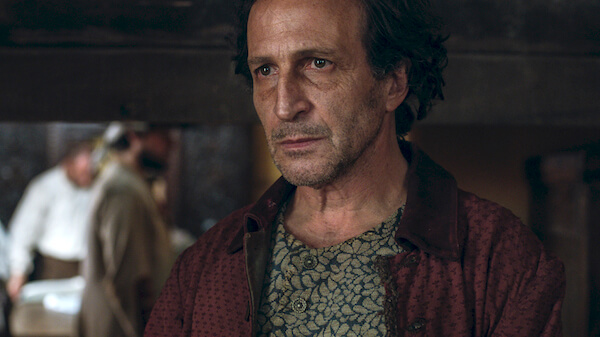“Marlina the Murderer In Four Acts” director Mouly Surya on set.| KIMSTIM/ ICARUS FILMS
Entry Point No. 1: Global Cinema
Reviewing director Mouly Surya’s “Marlina the Murderer in Four Acts,” critic Peter Bradshaw very bluntly summed it up as “Leone meets Tarantino in Indonesia.” Put that simply, it sounds like a screenwriter’s pitch from Robert Altman’s “The Player,” though I can actually imagine the director approaching producers with that exact description of her film — which does sound quite viable commercially.
Within the film’s first 15 minutes, I knew exactly what Bradshaw meant. Zeke Khaseli and Yudhi Arfani’s score self-consciously evokes Ennio Morricone’s music for Sergio Leone’s spaghetti Westerns, especially when it cranks up the electric guitar and its percussion sounds like horses’ hooves. The narrative of the first act — in which Marlina (Marsha Timothy) defeats the men who invade her home, threaten to steal all she has, and abuse her sexually by killing them with poisoned soup — seems inspired by a subplot of Quentin Tarantino’s “The Hateful Eight.”
The Western genre as a whole seems to be a reference point: there are repeated scenes of Marlina on horseback. These are the most stylized images in the film, in which the cinematography flickers in and out as if the sun were keeping the camera from staying in focus. Surya seemed to shoot the film in the fall: most of the vegetation she shows is arid or dying. The dominant colors of “Marlina the Murderer in Four Acts” are yellow and brown.
But the differences between Surya’s sensibility and that of Leone and, especially, Tarantino are telling, to the point where her film seems equal parts homage and critique. Unlike both of them, she doesn’t fetishize violence. Odd though it may sound given this film’s very title, she only seems interested in it as an element for her storytelling, not something to depict. A scene where Marlina murders a man with a machete while he is raping her is staged with almost no gore.
Entry Point Two: Indonesia
Surya’s first two films, “Fiksi” and “What They Don’t Talk About When They Talk About Love,” didn’t get US distribution, and I can’t even recall them playing New York. The original idea for this film came from Garin Nugroho, who has been called “Indonesia’s most revered director,” but even he is pretty far from a household name here.
Indonesia is the most populous Muslim-majority country in the world, but most Americans associate Islam entirely with the Middle East. Westerners have been in control of the few images we have of Indonesia: the two films about the country that got anything approaching wide American distribution, the harrowing and scathing political documentary “The Act of Killing” and the ultra-violent action film “The Raid,” were made by Western directors. (To be fair, “The Act of Killing” director Joshua Oppenheimer says that he worked with an Indonesian collaborator whose name can’t be publicly used for fear of retribution.)
It took four countries — Malaysia, Thailand, and France as well as Indonesia — to produce “Marlina the Murderer in Four Acts” and a partnership of two distributors to bring it to American theaters, despite its many Western points and general accessibility. It’s hardly arcane, but it’s genuinely different. If Americans knew more about Indonesia, we’d do a much better job of parsing out that difference. The other Indonesian-directed films I’ve seen lie far in the pasts of New Directors/ New Films and the New York Asian Film Festival.
Entry Point Three: #SheToo
“Marlina the Murderer in Four Acts” is the third film I’ve reviewed in two months by a female director about a woman trying to get justice for male violence against her. During that same period, Jennifer Fox’s “The Tale,” an autobiographical examination of a middle-aged filmmaker’s processing of her molestation at age 13, aired on HBO after getting the most praise of any film at Sundance last winter. Clearly, these kinds of stories are in the air now, although it’s still too early for films consciously inspired by the #MeToo movement to have been completed.
But Surya’s story is feminist in a very particular way. She films her star in much the same way Leone turned Clint Eastwood and Akira Kurosawa made Toshiro Mifune into icons, but with constant references to the demands of women’s bodies. Dialogue about pregnant women suggests they’re perceived as especially lustful. The spaghetti Western genre as a whole was partially an act of film criticism turned in a political direction; many of its writers and directors were Marxists working at the height of ‘60s rebellion. Leone’s films are undeniably sadistic, but they turn his enthusiasm for violence toward a radical critique of American lies and hypocrisy about our “taming of the land” and “spreading civilization.”
If Tarantino were a sharper thinker, he could turn his similar tendency to make films based on other films toward the same kind of critique; so far, it’s only worked in “Django Unchained” (which borrows heavily from spaghetti Westerns, beginning with its title.)
But Surya takes a mostly male genre mythos and claims it for women. Whatever the zeitgeist is a year from now, that will still stand beyond mere topicality.
Entry Point Four: The Unique Parts Surya is refreshingly open to sheer weirdness and surrealism. Despite its narrative, “Marlina the Murderer in Four Acts” is often rather quiet, even hushed, especially after the first act. But Marlina starts being followed by the headless ghost of the man she killed. She also carries around his head. Even when she rides the bus, though other passengers find this notable, no one reports her to the police or tries to kick her off.
Ultimately, “Marlina the Murderer in Four Acts” isn’t just a cool genre riff. It adds up to something more than “Leone meets Tarantino in Indonesia.” Surya’s direction and, after the first act, her pacing come closer to an arthouse tradition than a genre one. (One shot of a bus very slowly winding through a road in extreme long shot as we hear its passengers’ voices is far more reminiscent of Abbas Kiarostami than any images from a Western or conventional genre film.)
This film is clearly trying to appeal to both Western and Asian audiences without compromising itself: a hybrid in a much different way than Leone’s English-dubbed films starring Eastwood were. Watching Surya’s commanding framing of the rural landscape on my laptop, I realized how much I was missing out by not seeing it on the big screen. But can any Indonesian film — no matter how beautiful — play a theater for more than a week or two in an American culture that detests subtitles? Good luck to Surya and Marlina.
MARLINA THE MURDERER IN FOUR ACTS | Directed by Mouly Surya | In Indonesian with English subtitles | KimStim/ Icarus Films | Opens Jun. 22 | IFC Center, 323 Sixth Ave. at W. Third St. | ifccenter.com



































